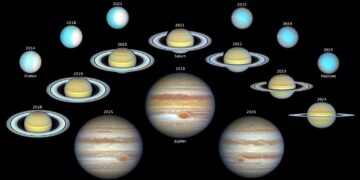The NASA Hubble Space Telescope’s Outer Planet Atmospheres Legacy (OPAL) program has reached a remarkable milestone: a decade of detailed, consistent observations of the solar system’s outer planets—Jupiter, Saturn, Uranus, and Neptune.
What Is the OPAL Program?
The OPAL program, initiated in 2014, was designed to build a long-term archive of atmospheric dynamics for the solar system’s gas giants. Hubble’s unique capabilities allow it to capture high-resolution images across a range of wavelengths, providing unparalleled insights into these planets’ complex weather systems. Unlike short-term missions like Voyager, OPAL offers consistent annual observations, enabling scientists to track long-term trends and serendipitous phenomena.

NASA, ESA, Amy Simon (NASA-GSFC), Michael H. Wong (UC Berkeley); Image Processing: Joseph DePasquale (STScI)
The program focuses on each outer planet when it is closest to Earth, ensuring detailed imaging.
Jupiter: A Kaleidoscope of Constant Change
Jupiter, the largest planet in the solar system, serves as a laboratory for studying extreme weather. Through OPAL, Hubble has closely monitored the evolution of Jupiter’s Great Red Spot (GRS), the largest storm in the solar system. Once large enough to engulf three Earths, the GRS has been shrinking steadily while its winds have been accelerating. This paradoxical behavior has intrigued scientists, who are using OPAL data to unravel its mysteries.
Hubble’s observations also reveal the presence of mysterious dark ovals in Jupiter’s polar regions, visible only in ultraviolet light. These features highlight the importance of studying multiple wavelengths to uncover hidden aspects of planetary atmospheres. By analyzing Jupiter’s cloud bands, cyclones, and anticyclones, OPAL has provided invaluable insights into the planet’s atmospheric dynamics and its subtle seasonal changes.
Saturn: The Lord of the Rings Under Constant Observation
Saturn, with its iconic ring system, offers a unique spectacle for planetary scientists. Hubble’s OPAL program has captured seasonal changes in Saturn’s atmosphere, tracking subtle variations in cloud color and composition. These changes are influenced by Saturn’s 29-year orbit, with seasons lasting approximately seven Earth years.
One of the most intriguing phenomena observed by OPAL is the appearance of ring spokes—dark, ghostly features that traverse Saturn’s rings. These spokes, first observed by Voyager, have been linked to seasonal shifts and changes in Saturn’s magnetic field. By monitoring their frequency and contrast, Hubble has provided a deeper understanding of this enigmatic phenomenon.
OPAL’s long-term observations have also captured the tilting of Saturn’s rings relative to Earth, showcasing their stunning geometric shifts.
Uranus: A Planet of Extreme Seasons
Uranus, often overlooked in planetary studies, has been a focal point for OPAL due to its unique axial tilt. The planet’s spin axis lies almost in the plane of its orbit, causing one hemisphere to remain in darkness for decades. As Uranus approaches its northern summer solstice in 2028, OPAL has documented the brightening of its polar cap, likely caused by photochemical reactions in the atmosphere.
Hubble’s observations have revealed methane ice-crystal clouds and small storms near the boundary of Uranus’ polar cap. These findings highlight the dynamic nature of the planet’s atmosphere and its response to solar radiation. By tracking these changes, OPAL provides critical data for planning future missions, such as NASA’s proposed Uranus Orbiter and Probe, which aims to explore the planet’s atmosphere, magnetic field, and moons.
Neptune: A Planet of Fleeting Storms
Neptune, the farthest major planet in the solar system, is renowned for its transient dark storms, first observed by Voyager in 1989. Hubble’s OPAL program has documented the full lifecycle of these storms, which emerge, migrate, and dissipate over a few years. This contrasts sharply with Jupiter’s long-lived GRS, offering a comparative study of storm dynamics on different planets.
One of the most surprising discoveries from OPAL is the correlation between Neptune’s cloud activity and the Sun’s 11-year solar cycle. Despite receiving only 1/1000th of the sunlight Earth does, Neptune’s weather appears to be influenced by solar activity, raising questions about the interplay between planetary atmospheres and solar radiation.
Why the OPAL Program Matters
The OPAL program is not just about studying distant planets; it has profound implications for our understanding of planetary weather systems and climate dynamics. By tracking the long-term behavior of the outer planets, scientists gain insights into the processes that shape atmospheric evolution, both in our solar system and beyond.
The data collected by OPAL also serves as a comparative tool for studying exoplanets. Many exoplanets discovered to date are gas giants orbiting close to their stars, making the study of Jupiter, Saturn, Uranus, and Neptune essential for interpreting exoplanetary atmospheres.
A Legacy of Discovery
As we celebrate this milestone, we are reminded of the importance of perseverance and innovation in scientific research. The OPAL program, with its decade of achievements, exemplifies the spirit of discovery that drives humanity to reach for the stars. Whether you’re a scientist, a student, or a casual stargazer, the lessons from Hubble’s observations remind us of our shared curiosity and our endless quest to understand the universe.



















